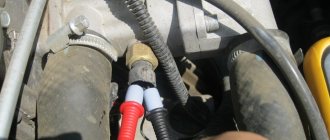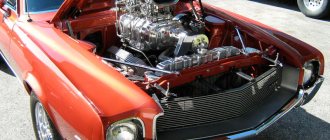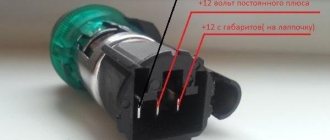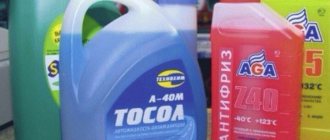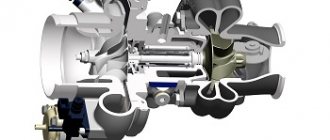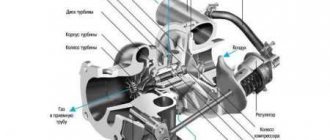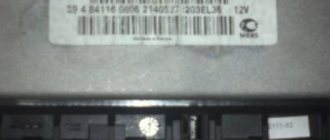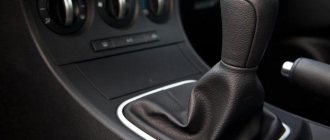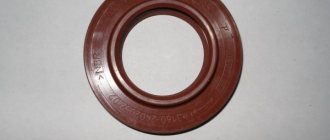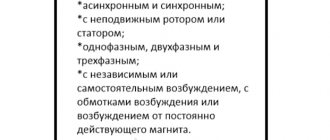The number of cars produced with turbocharged engines is constantly growing, as such cars are in demand in the market. However, not all car owners know how a turbine on a gasoline engine works, although they show interest in this topic. The point here is not laziness at all, but an overly complex presentation of the material, making it inaccessible to understanding for most motorists.
First you need to understand what a turbine is for : it allows you to increase the power of a small engine without harming it and without increasing fuel consumption. But there are certain operating features, the observance of which will make it possible to increase efficiency and extend the total operating time of the power unit.
At what speed does the turbine “turn on” (turbo boost)
Many drivers are convinced that the turbine turns on only at high speeds, since at low speeds they do not feel the effect of turbocharging on movement. This is a half-truth - in fact, the turbine on the car works constantly, but at low speeds the discharge is weak. Let's take a closer look at it:
- When the engine operates at up to 1500-2000 rpm, the exhaust gases create only a slight pressure on the turbine blades. Therefore, a small amount of oxygen is pumped into the internal combustion chamber, so the driver does not feel an increase in power. This phenomenon is called turbo lag.
- As power increases above 2000 rpm, exhaust gases begin to affect the turbines, which leads to a noticeable injection of oxygen into the internal combustion engine. The relationship here is directly proportional - the higher the speed, the stronger the turbocharging will work and vice versa. This phenomenon is called turbo boost.
Note! Many turbines are equipped with a safety valve that blocks operation of the device at very high speeds (red zone of the tachometer). This is done so as not to damage the engine.
Turbocharged engine: advantages and disadvantages
The popularity of turbo engines is due to their advantages over conventional ones, which include:
- increasing power up to 30% and reducing fuel consumption (a turbo engine will consume less fuel than an internal combustion engine of similar power, but without a turbine);
- reducing environmental pollution;
- better ratio of unit weight to developed power;
- quieter operation of the mechanism;
- opportunities to optimize other engine parameters.
However, there are also some disadvantages:
- demands on the quality of oil and gasoline, which ultimately increases the cost of operating a car;
- complex repairs that require the use of special equipment, which is unlikely to be performed on your own. Often the turbine turns out to be completely unsuitable for repair, and its complete replacement significantly impacts the car owner’s wallet.
Why the turbine may not turn on - malfunctions
When driving a car with a turbocharging system, the driver may encounter many problems and malfunctions. Let's look at the main problems and methods for solving them:
- Safety valve malfunction . It happens that the valve becomes clogged with debris or cracks, which leads to blocking the operation of the turbine. It is quite simple to establish a breakdown - up to approximately 3-4 thousand revolutions, the valve can still work, so it will pump air. However, if this indicator is exceeded, it abruptly closes the turbine, which leads to a drop in power. To solve the problem, turn off the car's electronic systems, open the hood, disconnect the negative terminal from the battery, find the turbine, turn off the lubrication system and remove the device (usually it is located next to the engine). Then remove the valve and inspect it, if necessary, clean the device or replace it.
- Leaky fastening of turbocharging components . To ensure maximum air injection power into the internal combustion engine, it is necessary that the turbine parts are hermetically attached to the vehicle. In the case of a leaky fastening, the pumping power drops sharply. The presence of a problem can be determined by two signs - a sharp decrease in power and the appearance of a characteristic whistle while the car is running. To deal with the problem, you need to turn off the power to the car, open the hood and check the tightness of the device. Problems may arise with the fitting, oil supply pipe, valve, and so on. To fix the problem, you need to restore the tightness (for example, if the problem is in the fitting, you need to buy a new one).
- Using bad oil . For the turbocharging system to operate effectively, the device must be lubricated with oil. However, it happens that the driver uses cheap, low-quality oil with a lot of impurities for lubrication - in this case, the efficiency of turbocharging will significantly decrease. It is very easy to identify the problem - while the car is moving, a sharp loud grinding noise appears in the car, and the engine power does not increase when accelerating to high speeds. The solution to the problem is to buy new high-quality oil and pour it into the car instead of the old one.
Turbine operation
The design of the turbocharger makes it dependent on the quality of the oil, so there is no point in trying to save money on it. Untimely oil changes can cause problems in the operation of the mechanism.
After purchase, a car equipped with a turbine requires an oil change and thorough cleaning of the fuel system; however, different oils cannot be mixed.
After a long trip, it is not recommended to immediately turn off the engine , allowing it to run a little and cool down. An abrupt shutdown may indicate a decrease in the strength of structural elements caused by temperature changes.
Myths about turbocharging in the engine
There are many myths among drivers about the operation of the turbocharging system. Let's look at the main stereotypes and find out why they are false:
| Myth 1 – the turbocharging system can be removed at any time without negative consequences | The design and volumes of the internal combustion engine chamber are adapted to the use of the turbine. If you dismantle this device, the torque and power of the engine decreases, and fuel consumption increases |
| Myth 2 – turbocharged engines break down much more often than naturally aspirated ones | Turbine engines have the same shelf life as conventional naturally aspirated engines. To reduce the risk of engine cracking at high speeds, they are additionally reinforced with metal sheets in problem areas |
| Myth 3 – the turbine quickly fails and will have to be replaced frequently | According to modern standards, the shelf life of a turbine is similar to or even slightly longer than the shelf life of the internal combustion engine itself. If you follow basic driving and maintenance rules, the turbo will last as long as the car itself. |
| Myth 4 – the turbine needs special careful care so that it does not break. | For turbocharging to work for a long time, it will be enough to adhere to the basic rules of car operation. Namely - change the oil on time, monitor the pressure level in the engine (do not bring it to the red line), troubleshoot problems in a timely manner |
In fact, the turbine always works, but at low speeds the air injection level will be low due to turbo boost.
Let's summarize. A turbine (turbocharging) is an auxiliary element of the engine, with the help of which air is forced into the internal combustion chamber of the engine. The device starts immediately after activating the engine, but the rule is that the higher the speed, the greater the boost (at low speeds the boost is almost imperceptible). The main problems with the turbine are valve failure, leaky fastening of spare parts, and the use of low-quality oil.
Turbocharging device
The turbine of a gasoline consists of the following elements :
- Bearing housing housing a rotor with a shaft and rings with blades. As they rotate, they redirect air into the cylinders.
- Channels running through the entire body. Their function is to deliver oil to rotating and rubbing elements, which helps to increase their service life.
- Sleeve bearing guarantees smooth operation of the rotor, lubricated and cooled by oil.
- A casing shaped somewhat like a snail, protecting the component elements of the mechanism from mechanical damage.
How to properly operate a turbocharged engine?
If you follow all operating rules, an engine equipped with a turbocharger can last about 500 thousand kilometers. There are cases when the engine “outlived” its own car. The body rotted, and the engine was installed on another car and continued to be used.
- Fill your gas tank with only the highest quality fuel. Do not refuel at questionable gas stations. The same applies to motor oil. Low-quality oil will very quickly lead to expensive repairs of a turbocharged engine. In addition, it is necessary to check the oil level more often.
- Operating at idle speeds that exceed the normal values for longer than 30 minutes is unacceptable. If your idle speed is set too high or low, be sure to adjust the carburetor or reprogram the fuel injection system.
- After each start of a turbocharged engine, it must be warmed up for at least two minutes. Only then can you start moving.
- If you decide to stop after a long trip, do not turn off the engine immediately. It is necessary to wait until the turbocharger cools down at idle speed (about 2-3 minutes) and only then turn off the ignition.
- Always carry out engine maintenance activities in a timely manner. This means changing oil and consumables.
This is how a turbocharged engine works. If you are not afraid of all the difficulties of operation and increased fuel consumption, then you can easily install a similar unit on your car. However, it is worth noting that if you plan to install such an engine in your car, you will need to have the engine re-registered accordingly with the traffic police.
Compressor block
The part of the turbine through which atmospheric air is forced is called a compressor. Main components: housing (cold volute), rotor. The rotor is rigidly mounted on a common axis with the turbine impeller. When the first one rotates, the rotor wheel moves in the opposite direction. Due to the rotation of the aluminum rotor blades, the air is drawn in by a vortex flow, the air pressure increases due to the flow transition from the center of the rotor to its walls.
Double turbine is used on multi-cylinder blocks
An air filter installed at the inlet to the intake manifold prevents dirt, small debris, etc. from entering the turbine.
Trusted manufacturers
When choosing to install a gasoline or diesel turbine, it is recommended to choose original units. Although many turbine repairmen are skeptical about all types of turbines, noting their rapid wear and tear, the original turbines still meet their specifications, although manufacturers, setting their service life equal to the life of the engine, are being dishonest. These manufacturers include the following brands:
- IHI – USA; • Borg Warner – Germany; • Garrett – USA; • Holset – England.
Holset produces turbines with sliding blades, but the units are designed only for trucks.
If we talk about diesel engines, then for them the installation of a turbine is absolutely justified - it is no longer possible to imagine a car running on diesel fuel without a turbocharger system. If we consider gasoline engines, then choosing a standard naturally aspirated engine is in many cases preferable to installing a turbine. As an alternative, to increase the power of a gasoline unit, a compressor ( supercharger ) is often used instead of a classic turbine.
Add ProCrossovers to your favorites
Turbine: how it works, why it breaks and is it easy to repair?
Turbine: how it works, why it breaks and is it easy to repair?
A turbine, or, as it is correctly called, a turbocharger, serves to pump air into the engine cylinders. The more air that enters the cylinders, the more fuel can be mixed with it, resulting in higher engine performance without increasing its displacement.
How the turbine works
The turbocharger is driven by the flow of exhaust gases: it does not have a rigid connection with any moving parts of the engine. This is the prerogative of, for example, a compressor that is driven directly from the crankshaft pulley. At first glance, the “turbine” is designed simply: imagine a shaft with two impellers at both ends. The impellers are placed in sealed housings, “twisted” one turn like snail shells. The turbine wheel is driven by the flow of exhaust gases: the exhaust gases act on the turbine blades, spin it and go further into the exhaust system through the central hole of the scroll. The compressor (pump) wheel connected by a shaft to the turbine wheel begins to rotate at the same speed and pump air into the intake manifold. The compressor sucks air through the central hole and transfers it to the blades. This ensures air injection at a given pressure. The compressed air is directed further into the engine intake system: it enters the cylinders, passing through the intercooler-radiator (intercooler). Compressed air needs cooling because... When compressed, air inevitably heats up. There is no point in supplying heated air to the combustion chambers: the engine efficiency instantly drops.
The turbocharger is equipped with a number of components that ensure its regulation, control and monitoring. Diesel engines often use “variable geometry” turbines. The geometry here really changes, but not the turbine as such, but its guide vane, which consists of blade strips built into the turbine “scroll.” These blades, like flaps on the wings of an airplane, change their position relative to the pump wheel. The blades are driven by a separate actuator controlled by a solenoid. The lower the speed of the diesel engine, the lower the flow and pressure of the exhaust gases. Consequently, the blades adopt a high angle of attack to force the gases more strongly onto the turbine blades. As the volume of exhaust gases increases, the angle of attack of the guide blades decreases. There is no guide vane for gasoline engine turbines - there is no need for it. The only gasoline turbo engines with adjustable turbine guide vane geometry are used on Porsche 4- and 6-cylinder boxer engines.
But on gasoline engines, double-flow turbines, in English terminology twinscroll, are becoming increasingly common. The bottom line is that the exhaust manifold, which supplies exhaust gases to the turbine, “collects” the gases into two separate channels. This separation (literally like a 4-2-1 manifold, also known as a "spider") reduces the back pressure of the gases in the exhaust manifold, improves its scavenging and ultimately improves engine efficiency slightly. In addition, the flow of gases to the turbine in this case is more uniform.
Any automobile turbines are equipped with a bypass valve (bypass, from the English bypass - bypass). This valve serves to bleed off excess air compressed by the compressor at the moment of abruptly closing the throttle (releasing the gas pedal). If this air is not bleed, it will flow out of the intake manifold back into the opposite direction of the rotation of the impeller, which may result in damage to the compressor rotor elements.
Turbochargers are also equipped with a wastegate or exhaust valve. This valve is called “westgate” (from the English wastegate - literally “waste gate”, or simply a bypass valve). It serves to direct part of the exhaust gas flow bypassing the turbine. At the same time, the rotation speed of the turbocharger rotor is limited and controlled. The wastegate is driven by a special actuator (“vacuum generator”), which is controlled by a solenoid. Typically the solenoid is connected to both the actuator and the intake manifold by vacuum tubes.
An important part of any turbocharger are the bearings that hold and rotate the shaft. Bearings definitely need lubrication and cooling with engine oil, which is supplied to them through specially designated channels. Sometimes, mainly on racing cars, the turbocharger bearings are cooled with antifreeze (it washes the races, not the bearings themselves).
The turbocharger as a whole is not considered a problematic and capricious element of the power unit. This part is capable of not causing problems for the entire service life of the engine. If you skimp on maintenance of the power unit or drive aggressively and carelessly, the service life of both the engine and the turbine will decrease.
Causes of turbine failures
Lack of lubrication and cooling
Most often, a turbine fails due to lack of lubrication of the bearings on which its shaft rests. The reasons that led to oil starvation should be sought outside the turbine. This failure leads to bearing wear and overheating: the oil not only lubricates, but also cools. Typically, due to oil starvation, the normal operating temperature of the turbine bearings and shaft jumps from 60-90°C to 400°C (the heat generated in the bearings during friction is added to the unresolved heat). At this temperature, the remaining oil literally burns, cokes and further clogs the oil-conducting channels and holes in the bearings. Overheated bearings running “dry” quickly wear out, and the gap increases to unacceptable sizes. Under such conditions, the turbine shaft may lose alignment. This in turn will lead to the fact that the turbocharger rotors will begin to touch the housings (“snails”). The turbocharger will suffer serious damage and either seize or destroy its internal parts.
How quickly the turbine breaks down and how serious the consequences will be depends on the nature of the oil starvation. An oil shortage can occur quickly. For example, in the event of a break in the oil pipe or a sharp decrease in the performance of the oil pump. Severe oil starvation can destroy a repaired or newly installed turbine. This trouble occurs when the turbocharger is installed incorrectly, when an air plug remains in the oil channels in the cartridge, which the oil is not able to push through.
Slow oil starvation develops under conditions of a slight lack of oil due, for example, to a decrease in the performance of the oil pump, coking of the oil line or their kinks.
Periodic oil starvation usually occurs when the turbo engine suddenly stops after heavy loads. In this case, lubrication and cooling stop, but a high temperature remains in the turbine cavities, at which the oil cokes and, if it does not clog the oil channels, then reduces their cross-sectional area. In the future, this can lead to slow oil starvation and associated breakdowns.
Contaminated oil
Often, engine oil contains wear particles from rubbing engine parts. If the filter does not retain the abrasive, it will inevitably end up in the oil passages of the turbine (and other important engine parts). As a result, the owner will face a breakdown caused by wear of the bearings and an increase in radial play. In any case, the facts leading to failure are in the engine, not in the turbine.
Entry of foreign objects
And here the reasons for the turbine malfunction, which occurred due to destruction or damage to its blades by solid particles, lie outside its body. To reach the rotor blades, usually a compressor rotor, foreign particles must enter the engine intake system. Typically, debris comes through a worn air filter or through loose intake connections. Small particles cause local damage to the rotor edges or their grinding.
Crankcase gas pressure
Crankcase gases circulate in the engine one way or another. They are formed when gases from the cylinders escape through the piston rings. Any engine is equipped with a ventilation system for these gases: without it, excess pressure would form inside the engine (under the valve cover and in the crankcase), which could squeeze out any engine seals (the first to fail in this case are the crankshaft or camshaft seals). In addition, crankcase gases carry particles of burnt fuel, which are usually filtered out in the exhaust system.
In short, if the crankcase ventilation system becomes clogged or its performance is reduced for other reasons, excess pressure can prevent oil from flowing from the turbine passages back into the engine. In this case, the oil will look for another path. Oil can leak into the cold (compressor) part: from here it enters the intercooler, and from there into the intake ports and, therefore, into the combustion chambers. Here it just burns out. As a result, you may encounter an “oil burn” that has nothing to do with the condition of the CPG.
If the oil goes into the hot (turbine) part, it will also burn under the influence of high temperatures. True, combustion will lead to the formation of an oil deposit - coking - inside the “snail”. Sometimes you have to deal with the fact that the amount of deposits is so large that the turbine rotor begins to touch it and stops rotating freely.
Also, crankcase gases can reach the lubrication and cooling points of the bearings. In this case, oil starvation and coking of the oil-conducting channels occur. All this again leads to failure of the turbocharger.
Symptoms of turbine malfunction
Any malfunctions in the air charging system are usually associated with untimely and poor-quality vehicle maintenance or its operation in extreme conditions. Regular maintenance according to the technology of the machine manufacturer and the use of certified materials (oils, filters, etc.) ensure reliability and reliability of the turbocharger.
The causes of turbocharger failures usually lie not in the turbocharger itself, but in the engine. If the turbine begins to give alarm signals, then in addition to repairing it, you need to take care of troubleshooting and eliminating it. Perhaps the breakdown was caused by one or another subsystem of the power unit. If the malfunction is not corrected, the repaired or new turbocharger installed in place of the defective one will quickly fail.
Symptoms of a turbine malfunction can be roughly divided into several large parts.
1. Decrease in engine power, decrease in acceleration dynamics. This symptom is felt instantly by the driver. It is not difficult to guess that the malfunction should be sought in insufficient air supply to the engine due to a faulty boost control system or its damage. If smoke appears in the engine compartment, you should look for an exhaust gas leak.
2. Smoke from the exhaust pipe is of a suspicious color: gray (white, blue) or black. Light-colored smoke coming out of the exhaust pipe during acceleration is the cause of oil combustion in the engine cylinders. It can get there due to leaks in the turbocharger. If oil gets into the combustion chambers, traces of it can be found in the intercooler and in the intake manifold.
The black color of the exhaust gases indicates the combustion of a rich fuel mixture in the cylinders. In this case, you should look for air leaks in the “cold” part of the turbocharger, including the intercooler and intake manifold.
1. Reduced oil level - this symptom may indicate both oil combustion in the cylinders and its leakage and combustion inside the turbine “scroll”.
2. Extraneous noise during operation of a turbocharger can be caused by either air or exhaust gas leaks or mechanical damage to the turbine (its impellers or bearings).
Turbine repair: repair or replacement?
Before you decide to manipulate the turbine, you need to determine the cause of the malfunction and eliminate it, because the problem may not be in the turbine at all. If, based on the diagnostic results, the turbine was “sentenced”, then there is no need to rush to replace it. A turbocharger is a unit consisting of a number of components that must be replaced and, sometimes, repaired. You can separately change any of the rotors, actuator, valves and even the turbine housing. Turbine repair kits with all necessary seals are also sold. The housing, as a rule, is dismountable: the turbine and compressor “snails” and the central part, called the “cartridge,” are separate. The cartridge includes the central part of the turbine with bearings, seals, shaft and both rotors. The cost of a cartridge varies from 200 to 350 rubles. Replacement will cost another 200 rubles.
The “basic” option for repairing a turbine is to replace it entirely. The cost of “used” turbines for popular car models varies from 180 to 500 rubles. Cost of new and refurbished turbines: from 600 to 1500 BYN. rubles and more.
In any case, a faulty turbine should be diagnosed and the failed parts should be identified. Spot replacement of parts can extend the life of a turbocharger and save money.
Necessary additions to the turbocharging system: valves, intercooler
It took engineers decades to create a truly efficient turbocharger. After all, it’s only in theory that everything looks smooth: by converting the energy of exhaust gases, you can “recover” the lost percentage of efficiency and significantly increase engine power (for example, from one hundred to one hundred and sixty horsepower). But for some reason this did not work out in practice.
In addition, when you pressed the accelerator sharply, you had to wait for the engine speed to increase. It happened only after a certain pause. The increase in exhaust gas pressure, the spin-up of the turbine and the injection of compressed air did not occur immediately, but gradually. This phenomenon, called “turbolag” (“turbo lag”), could not be tamed. And it was possible to cope with it by using two additional valves: one to bypass excess air into the compressor through a pipeline from the engine manifold. And the other valve is for exhaust gases. And in general, modern turbines with variable blade geometry, even in their shape, are already significantly different from the classical turbines of the second half of the twentieth century.
Bosch diesel turbocharger
Another problem that had to be addressed during the development of diesel turbine technology was excessive detonation. This detonation occurred due to a sharp increase in temperature in the working cavities of the cylinders when additional masses of compressed air were pumped into them, especially at the final stage of the stroke. The charge air intercooler (intercooler) is designed to solve this problem in the system.
An intercooler is nothing more than a radiator for cooling the charge air. In addition to reducing detonation, it also reduces the air temperature in order not to reduce its density. And this is inevitable during the heating process from compression, and from this the efficiency of the entire system drops significantly.
In addition, a modern engine turbocharging system cannot do without:
- control valve (wastegate). It serves to maintain optimal pressure in the system, and to release it, if necessary, into the exhaust pipe;
- bypass valve. Its purpose is to divert charge air back into the intake pipes up to the turbine, if it is necessary to reduce power and the throttle valve closes;
- and/or “blow-off-valve”. Which bleeds charge air into the atmosphere if the throttle is closed and there is no mass air flow sensor;
- exhaust manifold compatible with turbocharger;
- sealed pipes: air pipes for supplying air to the intake, and oil pipes for cooling and lubrication of the turbocharger.
What is turbojam or turbolag?
The principle of operation of turbocharging is that the engine “accelerates” itself due to its own work. This feature causes a problem such as turbo lag or turbo lag. It manifests itself in the form of a drop in power that appears after sharply pressing the gas pedal.
At the dawn of turbocharged engines, things got ridiculous - by pressing the gas pedal too sharply and too hard, you could completely turn off the engine. Nowadays, complex mechanical and electronic components will prevent this from happening, but the effect of turbo lag with an unpleasant loss of power still remains. This especially affects cheap turbo systems or those that are incorrectly installed and configured.
To smooth out turbo lag, they use clever electronic systems for proactively increasing speed. They register sharp presses on the accelerator pedal and spin the compressor using electric drives, without waiting for the turbine to “wake up”. The price of such solutions is usually quite high, so they are found mainly only on sports cars.
About the history of the invention and implementation of turbocharging
So, the idea of “putting into action” the energy of exhaust gases appeared soon after the invention and successful experiments in the use of internal combustion engines. German engineers and pioneers of automobile and tractor construction, led by Diesel and Daimler, conducted the first experiments in increasing engine power and reducing fuel consumption by pumping compressed air from exhausts.
Gottdieb Daimler produced cars like this, and was already thinking about introducing a turbocharging system
But the first to build the first efficient turbocharger was not them, but another engineer, Alfred Büchi. In 1911, he received a patent for his invention. The first turbines were such that it was possible and advisable to use them only on large engines (for example, ships).
Next, turbochargers began to be used in the aviation industry. Beginning in the 1930s, the United States regularly launched military aircraft (both fighters and bombers) with gasoline engines equipped with turbochargers. And the first truck in history with a turbocharged diesel engine was made in 1938.
In the 60s, the General Motors Corporation produced the first Chevrolet and Oldsmobile passenger cars with turbocharged gasoline carburetor engines. The reliability of those turbines was poor, and they quickly disappeared from the market.
1962 Oldsmobile Jetfire - the first turbocharged production car
The fashion for turbocharged engines returned at the turn of the 70s/80s, when turbocharging began to be widely used in the creation of sports and racing cars. The “turbo” prefix became extremely popular and turned into a kind of label. In Hollywood films of those years, superheroes pressed the “magic” turbo buttons on the panels of their supercars, and the car sped off into the distance. In reality, the turbochargers of those years noticeably “slowed down,” producing a significant delay in response. And, by the way, not only did they not contribute to fuel economy, but on the contrary, they increased its consumption.
A worker of Soviet fields - the K-701 "Kirovets" tractor with turbocharging
The first truly successful attempts to introduce turbocharging into the production of mass-produced automobile engines were carried out in the early 80s by SAAB and Mercedes. Other global engineering companies were quick to take advantage of this advanced experience.
In the Soviet Union, the development and introduction of turbocharged engines into the “series” was associated, first of all, with the development of the production of heavy industrial and agricultural tractors - “ChTZ”, “Kirovets”; BelAZ super dump trucks, etc. powerful technology.
Why did turbines eventually become widespread on diesel rather than gasoline engines? Because diesel engines have a much higher degree of air compression, and their exhaust gases have a lower temperature. Accordingly, the requirements for the heat resistance of the turbine are much lower, and its cost and efficiency of use are much higher.

